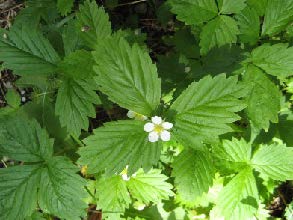Native Gardenscaping
- Patsy Cotterill

- Apr 2, 2024
- 2 min read
Native Ground Covers Common wild strawberry, Fragaria virginiana, is a low-growing perennial that forms excellent ground cover and is good for edging. It has a long flowering period beginning late May and its small strawberry fruits have great flavour. ENPS has not grown it from seed but it spreads readily by its overground runners which bud off new plants. In nature it grows in more disturbed habitats, such as trailsides and woodland edges, and open ground.
Alert walkers in natural woodland will notice a slightly different-looking strawberry with bright-green leaves (compared to the blueish-green leaves of common wild strawberry) which are more ovate and evenly toothed. This is the shade-loving woodland strawberry, Fragaria vesca. If you are in doubt as to the plant’s identity, check the terminal tooth on the terminal leaflet (of the three): in woodland strawberry it projects slightly beyond the two lateral teeth, whereas in common wild strawberry it is shorter and sunken below them.
Fragaria vesca, woodland strawberry.
Native Shrubbery
Another good way to occupy space in your garden with natives is to plant native shrubs, of which we have several species to choose from. Red-osier dogwood, Cornus sericea, is very commonly planted as it has a number of advantages for landscaping. In nature it prefers moist habitats but does well in most gardens and civic beds. It can be grown from seeds (with time) or from cuttings. Clusters of tiny white flowers appear amid the abundant, large-leaved foliage in late May-June and sometimes again in late summer, followed by white berries that are relished by birds. The red stems of younger plants are especially attractive in winter. When stems get old and grey and leggy they should be pruned out. I’d be interested to know how long these shrubs live in garden situations before they become old and unsightly and need replacing. In natural communities they are often heavily browsed by moose and deer and so retain their bushy, red stems for very long periods. Cornus sericea, red-osier dogwood. All photos P. Cotterill









